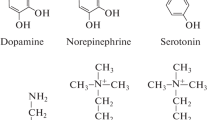Summary
The serotonin content of growing fruits and of germinating seeds of Juglans regia has been studied. In the embryo 0.4–0.6 mg serotonin/g FW were found; in contrast no serotonin was detectable in the fleshy pericarp and in the seed coat. Serotonin was also not detectable in leaves, stems and roots of the adult plant. Most of the serotonin found in the embryo is formed after abscission of the seeds. During the synthesis of serotonin there are no dramatic changes in the chemical composition of the seeds (Tables 3–5).
The formation of serotonin could be followed in isolated cotyledons and under sterile conditions. This serotonin formation is stimulated by exogenous tryptophan (Fig. 2). That tryptophan acts as a precursor of serotonin could be demonstrated with labelled DL-tryptophan (benzene ring 14C) (U). The possibility of stimulating serotonin formation in isolated cotyledons by the addition of tryptophan is limited to a certain stage of development and cannot be observed with material from fully matured seeds (Fig. 3).
No serotonin was found in callus tissue and adventitious roots formed by isolated cotyledons; all the serotonin remained in the cotyledons. This was also the case in young seedlings, in which only the cotyledons showed the characteristic high serotonin content, whereas leaves, stems and roots contained no serotonin (Table 6).
From these data we conclude that serotonin formation in the embryo of Juglans regia is not a special type of nitrogen storage but a way of ammonia detoxification in which ammonia from protein amino acid degradation is incorporated into serotonin via tryptophan.
Similar content being viewed by others
Literatur
Bowden, K., Brown, B. G., Batty, J. E.: 5-Hydroxytryptamine: Its occurence in cowhage. Nature (Lond.) 174, 925 (1954).
Bruce, D. W.: Serotonin in pineapple. Nature (Lond.) 188, 147 (1966).
Collier, H. O. I., Chester, G. B.: Identification of 5-hydroxytryptamin in the sting of the nettle (Urtica dioica). Brit. J. Pharmacol. 11, 186 (1956).
Deckwitz, R., Frowein, R., Kirberger, E., Kuhlenkampff, C., Mohs, U.: Über Normalwerte der stündlichen 5-HIES-Ausscheidung im Urin beim Menschen und die Messungen störender Faktoren. Klin. Wschr. 40, 285 (1962).
Fox, I. M., Parrat, I. R.: A note on the presence of noradrenaline and 5-Hydroxytryptamine in plantain (Musa sapientum var. Paradisiaca). J. Pharm. Pharmacol. 12, 360–365 (1960).
Kirberger, E., Braun, L.: Über das Vorkommen von 5-Hydroxytryptamin in der Walnuß (Juglans regia). Biochem. biophys. Acta (Amst.) 49, 391–393 (1961).
Marshall, B. P.: Catechols and tryptamines in the “matoke” banana (Musa paradisica). J. Pharm. Pharmacol. 11, 639 (1959).
Mothes, K.: Chemische Muster und Entwicklung in der Pflanzenwelt. Naturwissenschaften 52, 571–585 (1965).
—: Zur Problematik der metabolischen Exkretion bei Pflanzen. Naturwissenschaften 53, 315–323 (1966).
Murashige, T., Skoog, F.: A revised medium for rapid growth and bioassays with tobacco tissue cultures. Physiol. Plantarum (Cph.) 15, 473–497 (1962).
Nast, C. G.: The embryogeny and seedling morphology of Juglans regia L. Lilloa 6, 163–205 (1941).
Neumark, H.: Formation of serotonine in chopped green maize. Nature (Lond.) 201, 527 (1964).
Niaussat, P., Laborit, H., Dubois, C., Niaussat, M.: Action de la sérotonine sur la croissance de jeunes plantules d'Avoine. C. R. Soc. Biol. (Paris) 152, 945–947 (1958).
Rosen, H., Berard, C. W., Levenson, S. M.: A simplified procedure for automatic amino acid analysis. Analyt. Biochem. 4, 213–221 (1962).
Schraudolf, H.: Serotonin und Indolglucosinate in Tovarina pendula. Naturwissenschaften 56, 462–463 (1969).
Sjoerdsma, A.: Serotonin. New Engl. J. Med. 261, 181–188, 231–237 (1959).
Spackmann, D. H., Stein, W. H., Moore, S.: Automatic recording apparatus for use in the chromatography of amino acids. Analyt. Chem. 30, 1190–1206 (1958).
Stein, W. H., Moore, S.: The free amino acids of human blood plasma. J. biol. Chem. 211, 915–926 (1954).
Täufel, K.: Die ernährungsphysiologische Bedeutung der Eiweißpflanzen und Pflanzeneiweiße. In: W. Ruhland, Handbuch der Pflanzenphysiologie, Bd. VIII, S. 415–430. Berlin-Göttingen-Heidelberg: Springer 1958.
Udenfried, S., Weissbach, H., Brodie, B. B.: Assay of serotonin and related metabolites, enzymes, and drugs. In: D. Glick, Meth. biochem. Anal. 6, 95–130 (1958).
Waalkes, P., Sjoerdsma, A., Creveling, C. R., Weissbach, H., Udenfried, S.: Serotonin, norepinephedrin and related compounds in bananas. Science 127, 648 (1958).
West, B.: Tryptamines in edible fruits. J. Pharm. Pharmacol. 10, 589–590 (1958).
Author information
Authors and Affiliations
Rights and permissions
About this article
Cite this article
Bergmann, L., Grosse, W. & Ruppel, H.G. Die Bildung von Serotonin in Juglans regia L.. Planta 94, 47–59 (1970). https://doi.org/10.1007/BF00386608
Received:
Issue Date:
DOI: https://doi.org/10.1007/BF00386608




